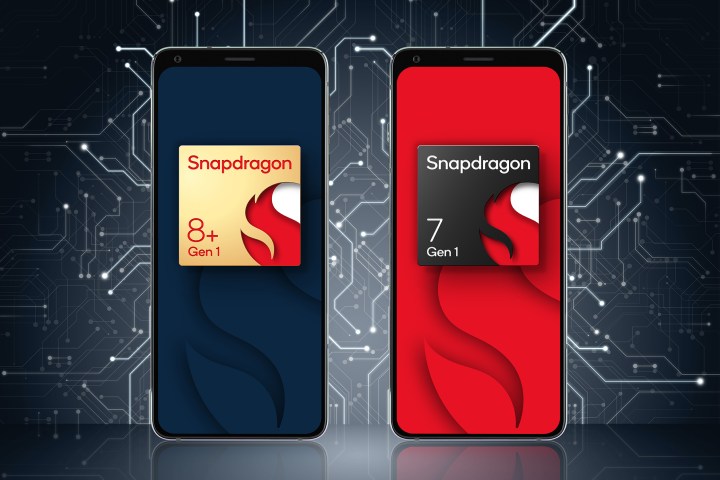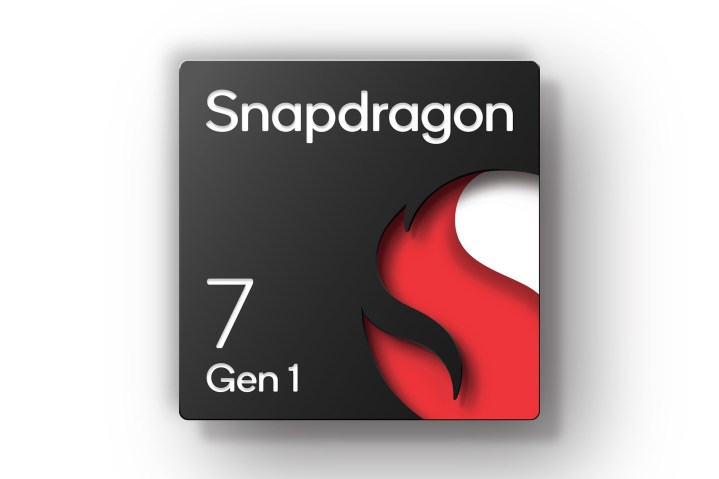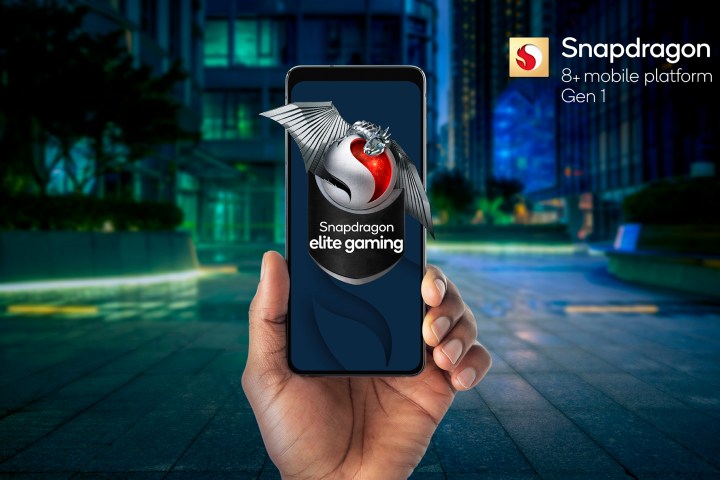Qualcomm today announced the Snapdragon 8 Plus Gen 1, the souped-up version of its flagship system-on-a-chip (SoC), while marking a shift to its newest naming scheme for the 700 series with its launch of the Snapdragon 7 Gen 1. Devices powered by these mobile platforms will arrive in the market starting in the current quarter of 2022. In addition, the chipmaker is betting big on a blend of augmented and virtual realities with the introduction of its new wireless smart glasses running on the Snapdragon XR2 platform.
Qualcomm dominates the mobile ecosystem with its vast array of silicon-based solutions for consumer electronics and telecom products. Its Snapdragon 800 series has been the default solution for smartphone manufacturers to power their high-end products. That remains true to date with leading devices, including the Galaxy S22 series, the OnePlus 10 Pro, Motorola Edge Plus (2022), and many more relying on the Snapdragon 8 Plus Gen 1 for breathtaking performance. In comparison, the MediaTek Dimensity 9000, Samsung’s Exynos 2200, and Google’s Tensor have only a handful of takers.

Despite the success of its Snapdragon 8 series chips, Qualcomm has been launching Plus variants to meet the headlong growth in the smartphone industry. The Snapdragon 8 Plus Gen 1 is subsequent to this demand and builds upon the already powerful Snapdragon 8 Gen 1 with new features for enhanced performance, better gaming, and more efficient artificial intelligence (AI) capabilities. Here’s what the latest flagship chipset brings to the table.
Qualcomm Snapdragon 8 Plus Gen 1

With the Snapdragon 8 Plus Gen 1, Qualcomm aims for higher performance and better power efficiency. The Snapdragon 8 Plus Gen 1’s prime core based on ARM’s Cortex X2 design has now been overclocked to a frequency of 3.2GHz, compared to the 3.0GHz clock speed of the non-Plus SoC. Meanwhile, the Cortex A710 performance and Cortex A510 efficiency cores continue to boast the same frequencies. The new flagship chip is also based on a 4nm process, the same as earlier.
Obvious performance improvements
In addition, the CPU and GPU power efficiencies have been improved by 30%. The overall power efficiency has also been enhanced by 15%, which could remedy the heating issues reported on the Snapdragon 8 Gen 1. For users, that means the chipset will be able to support longer gaming sessions and better-sustained workloads.
The new chipset also supports 8K video recording with support for HDR, HDR10+, HLG, and Dolby Vision. This has been available since the Snapdragon 8 Gen 1, but Qualcomm is billing a lengthened list of features as part of the new package. Likewise, the new chipset uses the same Snapdragon X65 modem with Qualcomm Fast Connect 6900 technology despite announcing the Snapdragon X70 modem earlier this month. For gaming, Qualcomm’s Elite Gaming features also support HDR gaming at 10-bit color depth, and that is also something that has been around for a while.
Among other features actually improved on the Snapdragon 8 Plus Gen 1 is the power efficiency of the A.I. engine on the chipset. Qualcomm claims a 20% increase in power output per watt of power delivered to the A.I. engine. This also translates to improvements in better face recognition with deep learning models and improved depth effects.

Qualcomm is rumored to be shifting back to TSMC for manufacturing the SoC after sourcing the Snapdragon 8 Gen 1 from Samsung. In March 2022, Korean publication The Elec first reported this possibility, citing Samsung Foundry’s low yield and a high percentage (~65%) of defective chips. Regardless of where Qualcomm gets its chips manufactured, the performance will remain unaffected, but the supply could improve.
Numerous customers lining up
Despite meager improvements, Qualcomm has a long list of takers for the new Snapdragon 8 Plus Gen 1. This list includes ASUS ROG, Black Shark, Honor, Lenovo and Motorola, Oppo and OnePlus, Vivo and its sub-brand iQOO, Xiaomi and Redmi, and ZTE alongside its sub-brands Nubia and RedMagic. Surprisingly, the official announcement does not include Samsung despite an emerging leak suggesting that the Galaxy Z Flip 4 will be powered by the Snapdragon 8 Plus Gen 1.
While the Snapdragon 8 Plus Gen 1 only offers marginal improvements, Qualcomm’s Snapdragon 7 Gen appears to be the real champion of the show. Here’s what the new 7 series chip has to offer over the older products for the sub-flagship segment.
Qualcomm Snapdragon 7 Gen 1

The more intriguing announcement of the morning comes in the form of the new Snapdragon 7 Gen 1, which succeeds the Snapdragon 780G and the Snapdragon 778G Plus 5G mobile platform. The Snapdragon 7 Gen 1 is now built on a 4nm node compared to the predecessor’s 5nm process. The new manufacturing process offers better performance and power efficiency to the chipset.
The new Snapdragon 7 Gen 1 is rumored to be more similar to the 8 Gen 1 than it is to the older Snapdragon 700 series models. That is because besides being based on the same 4nm process, it’s being suggested that the Snapdragon 7 Gen 1 will be equipped with newer ARM Cortex A710 cores for performance and Cortex A510 cores for power efficiency — the same as the Snapdragon 8 Gen 1 and the more recent 8 Plus Gen 1.
Significant CPU and GPU upgrades
While Qualcomm refrains from sharing details about the microarchitecture and the clock speeds, noted leaker Digital Chat Station says there are four Cortex A710 cores clocked at 2.36GHz while the Cortex A510 cores have a clock speed of 1.80GHz. While these are in the same ballpark as the Snapdragon 780G, a more efficient manufacturing process is likely to boost performance.
Unlike the CPU, Qualcomm is sharing some stats about the GPU’s performance. The Snapdragon 7 Gen 1’s Adreno GPU brings 20% faster rendering, which will deliver smoother animations in the user interface and improved frame rate (expressed in frames per second or fps) while gaming. The chipset uses an Adreno 662 GPU as per the leaker quoted above. Considering the Snapdragon 888 comes with an Adreno 660, and the increment in numbering could imply better graphics performance.

For gaming specifically, the Snapdragon 7 Gen 1 borrows certain Elite Gaming features, such as the Frame Motion Engine, from the Snapdragon 8 Gen 1. Qualcomm claims this allows up to twice the frame rate at the same power consumption. For once, that could mean that the flagship Snapdragon 7 series chip could now support 60fps (or higher) in graphics-intensive games such as PUBG Mobile. The new chipset also supports Variable Rate Shading or VRS, which improves the frame rate by rendering different parts of the frame dynamically, so more GPU power can be used to process complex parts of the frame while less power is devoted to simpler parts.
Many firsts for the segment
Additionally, the improved GPU now also allows the Snapdragon 7 Gen 1 to support up to QHD+ displays compared to only Full HD+ on the Snapdragon 780G. The chipset also supports Snapdragon Sound for a more spatial and contextual audio experience while gaming.
The SoC also features an improved Spectra image signal processor (ISP) that supports up to a 200-megapixel camera sensor, a slight bump over the 192MP sensor supported earlier. Does that mean we will have smartphones with a functional 200MP camera? We don’t know for sure, and only time will tell. We already have 200MP sensors in the market, and the new chipset could kick off their adoption.
The Snapdragon 7 Gen 1 also features a newer, 7th-generation Hexagon A.I. engine, offering a 30% improvement in A.I. applications. Qualcomm claims the new A.I. engine enables better face detection and autofocusing capabilities, even when a person is wearing a mask.
Qualcomm also extends its Trust Management Engine (TME) to the Snapdragon 7 Gen 1 for better security. The TME is a chipset-level encryption system that prevents malicious code injection into the system files related to Android. This means it protects supported smartphones against malware. Until now, the system had been limited to the Snapdragon 8 Gen 1, and the Snapdragon 7 Gen 1 is the first SoC in the Snapdragon 7 series to feature it.
Seamless 5G, Wi-Fi 6E
Last, the chipset relies on a Snapdragon X62 5G modem with FastConnect 6900. The modem supports download speeds of up to 4.4 gigabits per second (Gbps) with a 2×2 MIMO (multiple-input multiple-output) stream on mmWave and 4×4 MIMO sub-6GHz 5G signals. Meanwhile, the FastConnect technology enables Wi-Fi 6E — with tri-band functionality — and Bluetooth 5.3 and Bluetooth LE Audio support.
Honor, Oppo, and Xiaomi will be the earliest adopters of the Snapdragon 7 Gen 1 chipset.
Besides the two new mobile platforms, Qualcomm has also announced a new solution that lays the foundation for the future of mobile computing.
Qualcomm AR Smart Viewer

The growing popularity of augmented and virtual realities and the growth of the buzz around the metaverse compels us to envision a future where we will interact with our environments through better utilization of technology. Technologies such as AR and VR will play a significant role in dissolving boundaries between the digital and the physical worlds, and Qualcomm shows us how it may be done in the next few years.
Alongside the Snapdragon 8 Plus Gen 1 and Snapdragon 7 Gen 1, Qualcomm showcased a reference prototype for wireless AR glasses. Dubbed the AR Smart Viewer, these glasses are powered by the Snapdragon XR2, Qualcomm’s existing platform for AR and VR headsets, including the Oculus Quest 2 by Meta. The Smart Viewer has been developed by the Chinese company, Goertek.
The lenses for each eye have a smart OLED display with a resolution of 1920 x 1080 and a 90Hz refresh rate for reduced motion blurring. Along with heads-up displays for each eye, the Smart Viewer also features two black-and-white and one colored camera to track movements of the head and hand gestures in six degrees of freedom.
Workload distributed between smart glasses and phone
The smart glasses are designed so that the workloads are distributed between them and a connected smartphone or a hub where most of the processing happens. Since this is a wireless exchange of information, latency is bound to creep in, but Qualcomm claims the Snapdragon XR2 platform can cut it down to less than three milliseconds.

The reference design supports Wi-Fi 6 and 6E alongside Bluetooth, while Qualcomm also suggests future variants are expected to feature 5G connectivity for seamless machine-to-machine (M2M) interactions. Besides seamless connectivity, Qualcomm focuses on the ease of sporting these smart glasses. The Smart Viewer powered by the Snapdragon XR2 platform is 40% thinner than the older reference design powered by the XR1 platform.
As expected, consumers will not be able to buy any devices based on Qualcomm’s reference design anytime soon. The commercial product is the Oppo Air Glass which offers AR experiences through a lightweight monocle form-factor and stand-alone processing capabilities, thanks to Qualcomm’s Snapdragon Wear 4100 platform.
Snapdragon 7 Gen 1 is the underrated hotshot
While the Snapdragon 8 Plus Gen 1 is likely to soak up most of the spotlight for its flagship status, it feels pretty lackluster in front of the Snapdragon 7 Gen 1, which brings substantial upgrades over any previous Snapdragon 7 series chipset. The Snapdragon 7 Gen 1 borrows many features from the likes of Snapdragon 888 and the Snapdragon 8 Gen 1, while its efficient design can be expected to plug the gap between high-grade mid-rangers and entry-level flagships. It could be a merited successor to rehashed versions of older flagship chipsets, including the Snapdragon 860 and Snapdragon 870, and an ideal rival to MediaTek’s Dimensity 1300 and the Dimensity 8000/8100 chipsets.
With the Snapdragon 7 Gen 1’s enhanced performance and gaming capabilities, we can expect to see a new sub-category of flagship devices being created, especially catering to price-conscious customers who want a reliable performance without hiccups.


